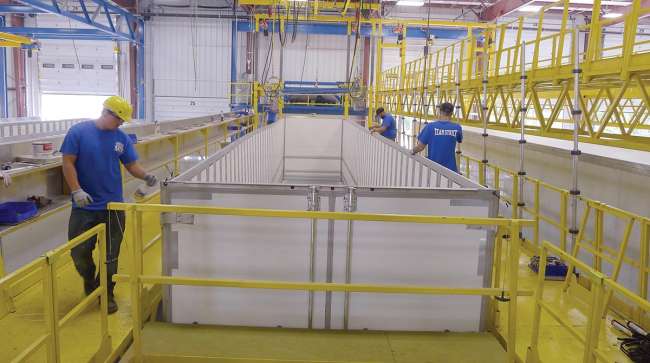Trailer Orders Surge in December, Close in on All-Time High

U.S. trailer orders soared in December to record levels — the second-highest all-time, according to one analyst — as manufacturers ended a busy, successful year on a high note.
ACT Research Co. reported that sales rose to 45,200, trailing only October 2014’s total of 47,512. The company cited preliminary data it would revise after receiving final data from the trailer makers — while expecting its estimate to be 3% plus or minus of the final tally. That lifts the high end of that window to 46,600.
Preliminary net trailer orders for December: over 45,000 units, supported by solid dry van and reefer volume. — ACT Research (@actresearch) January 15, 2018
For the year, ACT said fleets ordered more than 313,000 trailers, a 38% improvement versus 2016. That ranks 2017 as the third-highest order year in history, trailing only 2014 and 2015. Eight of the ten trailer categories it tracks were positive year-over-year, with bulk tanks, flatbeds and dry vans posting the strongest gains.
“I was expecting a solid number, but this was a little stronger than I might have thought. But directionally, it was the way I expected things to go,” said Frank Maly, ACT’s director of commercial vehicle transportation analysis and research.
2017 net trailer orders totaled more than 313,000 units, third best annual volume in industry history. — ACT Research (@actresearch) January 15, 2018
Research firm FTR pegged preliminary orders at 47,000, putting pressure on the October 2014 result.
“We are ‘in the best of times’ to be a trailer maker,” David Giesen, Stoughton Trailers vice president of sales, told Transport Topics. “Demand has been strong and is forecasted to remain strong.”
Also, the surge in orders pushed out the current production backlog to the second half of the year, Maly said.
“We are telling customers when we can build their orders. In most cases, it is out longer than they would like, but they accept the reality,” Giesen said.
Fleets are using trailers to overcome capacity shortages and driver shortages, said Don Ake, FTR’s vice president of commercial vehicles.
“It’s back to the pressure on the market. I don’t know how many trailers you can add. At some point, it doesn’t work, and I thought we’d reached that saturation point in 2017. Evidently, we haven’t,” he said.
Operationally, fleets are doing more drop-and-hook with trailers to compensate for the lack of drivers, according to FTR.
Also, the stay in the federal Phase 2 greenhouse gas emissions rule that applies to trailer makers brought some buyers off the sidelines, Maly said.
“These rules are under an indefinite stay, and there certainly is no indication that they are going to back out of limbo and become a factor in the short to medium term,” Maly said. “So that helped people, finally, implement some of their plans [based on a business decision rather than a regulatory requirement].”
The rising demand has created some “material constraints” from two of Hyundai Translead’s suppliers, Chief Sales Officer Glenn Harney said, but he declined to identify them. “We are hoping they can address the issues sooner rather than later,” he said. Harney described December as a good month “but not our best ever.”
David Gilliland, Great Dane Trailers vice president of national accounts, agreed material costs are rising, which he noted also affects suppliers and requires close communication to keep up with production.
He described December as “a very strong month, driven mostly by dry vans and flats.”
It has been a long time since Maly has heard of material constraints. “In the past, where we have had issues, things that popped up included axles and, maybe, suspensions,” he said.
Giesen said materials have not been a problem for Stoughton.
Utility Trailer Manufacturing Co. Inc. reported December was its best month of the year for orders, but not the best all-time. The company expects 2018 will be the probable peak for demand, and expects a modest easing after this year.
“Multiple trailer manufactures have added capacity with new production facilities recently,” said Brett Olsen, marketing manager at Utility. “This will ultimately increase the competitive nature of an already competitive business.”




